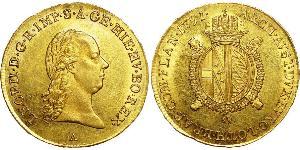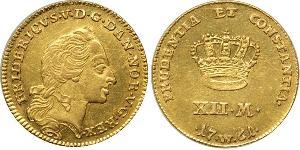(sold for $133.0)
1779, Electoral Paletinate (Pfalz), Charles Theodore. Silver Thaler Coin. VF-
Mint Year: 1779 Denomination: Thaler Reference: KM-470 ($175 in VF!) Condition: Cleaned/lightly polished, otherwise VF with minor mint-made planchet-imperfections! Weight: 27.74gm Diameter: 42mm Material: Silver
Obverse: Bust of Charles Theodor right. Legend: CAR . THEODOR . D : G . C . P . R . S . R . I . A . T . & . EL . Reverse: Crowned oval triple coat-of-arms. Date (17-79) and mint official´s initials (A-S) in below. Legend: AD NORMAM CONVENTION : * A-S / 1774 *
The County Palatine of the Rhine (German: Pfalzgrafschaft bei Rhein), later the Electorate of the Palatinate (German: Kurfürstentum von der Pfalz) or simply Electoral Palatinate[1] (German: Kurpfalz), was a territory in the Holy Roman Empire (specifically, a palatinate) administered by the Count Palatine of the Rhine. Its rulers served as prince-electors (Kurfürsten) from "time immemorial", were noted as such in a papal letter of 1261, and were confirmed as electors by the Golden Bull of 1356.
The fragmented territory stretched from the left bank of the Upper Rhine, from the Hunsrück mountain range in what is today the Palatinate region in the German federal state of Rhineland-Palatinate and the adjacent parts of the French regions of Alsace and Lorraine (bailiwick of Seltz from 1418 to 1766) to the opposite territory on the east bank of the Rhine in present-day Hesse and Baden-Württemberg up to the Odenwald range and the southern Kraichgau region, containing the capital cities of Heidelberg and Mannheim.
The Counts Palatine of the Rhine held the office of Imperial vicars in the territories under Frankish law (in Franconia, Swabia and the Rhineland) and ranked among the most significant secular Princes of the Holy Roman Empire. Their climax and decline is marked by the rule of Elector Palatine Frederick V, whose coronation as King of Bohemia in 1619 sparked the Thirty Years' War. After the 1648 Peace of Westphalia, the ravaged lands were further afflicted by the "Reunion" campaigns launched by King Louis XIV of France, culminating in the Nine Years' War (1688–97). Ruled in personal union with the Electorate of Bavaria from 1777, the Electoral Palatinate was finally disestablished with the German mediatization in 1803.
Charles Theodore, Prince-Elector, Count Palatine and Duke of Bavaria (German: Karl Theodor) (December 11, 1724 – February 16, 1799) reigned as Prince-Elector and Count Palatine from 1742, as Duke of Jülich and Berg from 1742 and also as Prince-Elector and Duke of Bavaria from 1777, until his death. He was a member of the House of Palatinate-Sulzbach, a branch of the House of Wittelsbach.
Karl Theodor was a great lover of the arts, including drama and especially music. His Mannheim court orchestra was considered one of the finest in its time. The Mannheim School (including composer Christian Cannabich and conductor Johann Stamitz) did groudbreaking work that the celebrated Wiener Klassik would later draw upon. Mozart applied for a position with the Mannheim orchestra in 1777, but was turned down, as the court was about to move to Munich. In 1780, Karl Theodor commissioned Idomeneo from the composer. Mozart quotes him as saying "No music has ever made such an impression on me. It is magnificent." (David Cairns, Mozart and his operas, 2006, p.48)
In keeping with the customs of the time, an Italian opera company as well as a troupe of French actors were employed at Mannheim, each performing in their respective tongues. Later, the Nationaltheater (national theatre) was established, one of the first theatres in Germany to exclusively showcase plays in the native tongue (most notably, the first staging of Schiller's "Die Räuber" in 1782).
In the visual arts, a massive collection of plaster casts taken from celebrated antique works was assembled at Mannheim. The preexisting Düsseldorf gallery, including many works by Rubens, was first transferred to Mannheim, then to Munich, where it was later incorporated in the Alte Pinakothek. While none of the Mannheim painters are particularly notable today (with the possible exception of Kobell, primarily a master of landscapes), the elector had several highly talented sculptors at his disposal, among them Verschaffelt, Simon Peter Lamine and Konrad Linck. Linck also distinguished himself as a designer of porcelain figurines at Frankenthal.
Karl Theodor's chief architect Nicolas de Pigage was charged to complete the Mannheim Palace, design the gardens at Schwetzingen Palace ( including numerous pavilions, among them several artificial "Roman" ruins and a "mosque") as well as Benrath palace. While these works are in a pure contemporary French style (marked by the transition from late Baroque to early classicism), some of the other architects employed by Karl Theodor were proponents of a more Italianate style. This mixture of influences is, in fact, typical of many German courts of the period.
Karl Theodor liked to style himself as a prince of peace, in contrast to other princes like his chief political opponent, the great warrior Frederick II of Prussia. Allegorically, Minerva, the Roman goddess of wisdom and protectress of the arts, is often depicted as a stand-in for the elector himself. This self-view is best summed up in the inscription of a small monument at Schwetzingen:
"A field of war and death of Romans and Germans has been discovered, through the unearthing of weapons, urns and bones, in the year 1765. - To the arts of peace, which are the sole joys of his life, the elector Charles Theodore has dedicated this spot, excavated to the height of seven feet, and had this monument erected in 1768."

|
Posted by:
anonymous 2018-07-09 |
1 Thaler Germany Silver Frederick III, German Emperor (1831-1888)
group has 2 coins / 1 prices
⇑
10 Corona Austria-Hungary (1867-1918) Gold Franz Joseph I (1 ...
group has 11 coins / 9 prices
⇑

















-300-150-SKcKbzbiJ5YAAAFGklQOlaMu.jpg)






